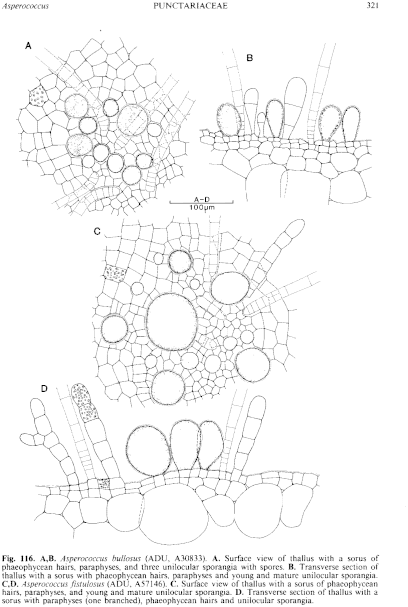|
|
|
|
|
|||||||||||
|
Electronic Flora of South Australia Species Fact Sheet
Phylum Phaeophyta – Order Dictyosiphonales – Family Punctariaceae
Selected citations: Knight et al. 1935: 87. Pedersen 1984: 18.
Synonym
A. echinatus (Mertens ex Roth)Greville 1830: 50, pl. 9. Hamel 1937: 222, fig. 43, vii. Harvey 1848: pl. 194. Rosenvinge & Lund 1947: 43, fig. 15. Taylor 1957: 169, pls 15 fig. 7, 16 figs 5,6.
Thallus (Fig. 114D) light to medium brown, simple, membranous, hollow, terete, usually (5–) 10–20 cm long and (2–) 3–10 mm in diameter, tapering slightly to the apex and gradually to the small, discoid, rhizoidal, holdfast 100–300 µm across; epiphytic on Heterozostera and rarely on larger algae (e.g. Scaberia). Structure of membrane (Fig. 1 16D) 120–200 µm and 2–3 (–4) cells thick, with a cortex of small phaeoplastic cells with several overlying each of the larger medullary cells; cortical cells more or less in rows, angular, isodiametric, (15–) 20–40 µm across in surface view (Fig. 116C), each with several discoid to elongate phaeoplasts with 1 (–2) pyrenoids. Phaeophycean hairs single or clustered, 14–20 µm in diameter.
Microthallus (unknown in Australia) filamentous, branched, hecatonemoid (Pedersen 1984, p. 18, figs 8,9).
Reproduction: Sort (Fig. 116C,D) rounded to elongate, densely scattered over the surface, 200–500 µm across, containing pyriform to globular, sessile, unilocular sporangia 45–100 µm long and 40–70 µm in diameter, together with phaeophycean hairs and numerous, relatively straight, paraphyses, 150–250 pm and 3–8 cells long, 22–28 µm in diameter with the cells L/B 1–1.5. Plurilocular sporangia unknown.
Microthalli with plurilocular sporangia producing zoospores which reproduce the microthallus (Knight et al. 1935, p. 87; Pedersen 1984, p. 18).
Type from England.
Selected specimens: American R. inlet, Kangaroo I., S. Aust., on outer tidal flats on Heterozostera (Womersley, 2.ix.1946; ADU, A3996); on Scaberia on red buoy (Womersley,
Distribution: Temperate N. Atlantic.
In southern Australia, from American R. inlet, Kangaroo I., S. Aust. to Apollo Bay, Vic. and the S.E. coast of Tasmania, in sheltered bays (probably more widespread than known records indicate).
Taxonomic notes: 31.x.1947; ADU, A6091); on Heterozostera near inlet mouth, upper sublittoral (Womersley, 23.viii.1948; ADU, A8569); on Heterozostera, 0–1 m deep near Muston (McKelvey, 8.ix.1986; ADU, A57146). Investigator Strait, S. Aust., 31 m deep, 35°28'S, 137°17'E (Watson, 23.i.1971; ADU, A41112). Apollo Bay, Vic., on Heterozostera in low eulittoral pools (Womersley, 13.x.1985; ADU, A56892). Stewarts Bay, Port Arthur, Tas., 1–2 m deep on Heterozostera (Womersley, 16.x.1986; ADU, A57257). Southport, Tas., drift (Gordon, 14.i.1966; ADU, A30011).
A. fistulosus differs from A. bullosus in dimensions, in usually (but not always) tapering gradually to the holdfast, in having only unilocular sporangia, and in the paraphyses which are more frequent and 3–6 (–8) cells long in the former, compared with usually only 2 cells long in the latter. Difficulties in separating these species on form have been commented on by Knight et al. (1935, pp. 83–85), and the differences in paraphyses need further study since ADU, A57257 includes abundantly fertile plants with 4–6 (–8) celled paraphyses together with less fertile plants with mostly 2–3 celled paraphyses, occasionally to 5 cells long.
A. fistulosus (based on Ulva fistulosa Hudson 1778, p. 569) appears to be the earlier name for this species which has been more commonly known as A. echinatus (Mertens ex Roth) Greville.
References:
GREVILLE, R.K. (1830). Algae Britannicae. (Edinburgh.)
HAMEL, G. (1937). Phéophycées de France. Fasc. III, pp. 177–240. (Paris.)
HARVEY, W.H. (1848). Phycologia Britannica. Plates 145–216. (Reeve: London.)
HOOKER, W.J. (1833). The British Flora. 4th Edn, Vol. 2: Cryptogamia. (Longman: London.)
HUDSON, W. (1778). Flora Anglica. 2nd Edn, Vol. 2. (London.)
KNIGHT, M., BLACKLER, M.C.H. & PARKE, M.W. (1935). Notes on the life-cycle of species of Asperococcus. Proc. Trans. Liverpool Biol. Soc. 48, 79–97.
PEDERSEN, P.M. (1984). Studies on primitive brown algae (Fucophyceae). Opera Bot. 74, 1–76.
ROSENVINGE, L.K. & LUND, S. (1947). The marine algae of Denmark. Vol. II. Phaeophyceae. III. Encoeliaceae, Myriotrichiaceae, Giraudiaceae, Striariaceae, Dictyosiphonaceae, Chordaceae and Laminariaceae. K. Dan. Vidensk. Selsk. Biol. Skr. 4(5), 1–99.
TAYLOR, W.R. (1957). Marine algae of the Northeastern coast of North America. Rev. Edn. (Univ. Mich. Press: Ann Arbor.)
The Marine Benthic Flora of Southern Australia Part II complete list of references.
Publication:
Womersley, H.B.S. (14 December, 1987)
The Marine Benthic Flora of Southern Australia
Part II
©Board of the Botanic Gardens and State Herbarium, Government of South Australia
Illustrations in Womersley Part II, 1997: FIGS 114D, 116C,D.

Figure 114 enlarge
Fig. 114. A. Punctaria latifolia (ADU, A54509). B. Asperococcus compressus (ADU, A57205). C. Asperococcus bullosus (ADU, A56299). D. Asperococcus fistulosus (ADU, A57146).

Figure 116 enlarge
Fig. 116. A,B. Asperococcus bullosus (ADU, A30833). A. Surface view of thallus with a sorus of phaeophycean hairs, paraphyses, and three unilocular sporangia with spores. B. Transverse section of thallus with a sorus with phaeophycean hairs, paraphyses and young and mature unilocular sporangia. C,D. Asperococcus fistulosus (ADU, A57146). C. Surface view of thallus with a sorus of phaeophycean hairs, paraphyses, and young and mature unilocular sporangia. D. Transverse section of thallus with a sorus with paraphyses (one branched), phaeophycean hairs and unilocular sporangia.

|
Email Contact: State Herbarium of South Australia |

|